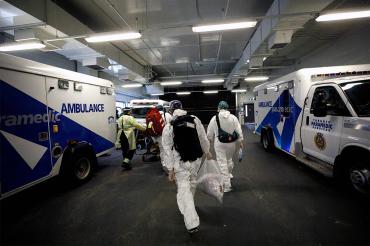Beyond emergencies: Researchers rethink the role of paramedics in the health system

Published: April 26, 2022
As a paramedic, University of Toronto alumnus Amir Allana routinely responds to a wide range of calls – from people suffering a heart attack or stroke to those experiencing mental health issues and addiction.
“On a given day, I might go from acute trauma to someone who’s 70 and has just had a fall but is otherwise uninjured,” says Allana, who recently defended his master’s thesis in the health services research program offered by the Dalla Lana School of Public Health’s Institute of Health Policy, Management and Evaluation (IHPME).
“The next call might be for someone who’s in a shelter system who has a number of chronic conditions that have gotten worse, or who just needs somewhere to go. You’re trying to navigate to what extent is this a health issue versus a social issue? Is this an addictions issue? You’re switching gears all the time, and a lot of it is case-finding, triage and navigation of the health system,”
In fact, Allana says that traditional medical emergencies account for only a small fraction of the cases he sees.
“It’s difficult for newer paramedics who spend all their schooling thinking about trauma and cardiac arrest, only to realize, ‘Oh, that’s just 10 per cent of what I do,’” he says. “Not enough education or cultural pieces are in place to tell them, ‘Actually, your role for the most part is diagnostics and care navigation. Your role is an extension of health services because you’re mobile in the community.’”
Allana and his co-supervisor, Andrew Pinto, an associate professor at the Dalla Lana School of Public Health and a family physician at St. Michael’s Hospital, recently published a paper in Healthcare Policy, that explores how paramedics can address social determinants of health more effectively.
Care could be improved, they argue, by equipping paramedics with tools for better social and environmental assessments. For example, questionnaires could be used to help paramedics assess patients for risks associated with housing, income and food insecurity. Paramedics could also address social factors linked to health by working directly with community-based organizations such as legal aid, shelters, detox centres, food banks and employment agencies. Allana says such an approach would require a shift in paramedic education, culture and governance.
His research also looks at integrated care and how paramedics can extend primary and preventive care in home and community settings.
Allana says the pandemic has exposed the vulnerability of the health system and provides an opportunity to think about how to restructure it in a way that leverages local agencies and services to improve outcomes.
“There are approaches to care that can be provided in the community, but require a rethink of the role of primary care, community-based nursing and mobile care teams – including paramedics and mental health services – to address people’s needs in a way that doesn’t rely just on doctors and nurses in a hospital,” he says.
In a study published in the International Journal of Integrated Care, Allana looked at 108 programs around the world that use paramedics in various care pathways in the community. He found paramedics bridged gaps in care by working across silos that exist between hospitals, social services, primary care and public health. For instance, paramedics in some jurisdictions work with primary care teams to address flare-ups of chronic diseases such as heart failure (when the heart is too weak to meet the body’s pumping needs) and chronic obstructive pulmonary disorder (a lung disease that causes breathing problems) by going into the community to address needs both reactively and proactively.
“Even something simple like weight monitoring for people with congestive heart failure can catch deterioration early,” says Allana. “Systems can be put in place by family health teams and paramedics to follow care plans and adjust medications. There’s something in the middle of purely scheduled primary care and highly acute unscheduled emergency care – there’s a big gap in the middle that no one fills, and a lot of new [paramedicine] programs are filling that.”
Allana says that, ultimately, a more expansive view of the profession is needed and that investing in the capacity of paramedics to provide urgent and preventive care will strengthen the health system for everyone.
“The use of emergency departments and hospital services has outstripped population growth for several decades and that’s going to continue to happen. The reason for that is you’re not providing appropriate care options in the community. We don’t have capacity in the acute care system to appropriately care for people. If you invest in prevention and care co-ordination, it’ll pay off in the long term and curb the need for additional emergency coverage over time.”


